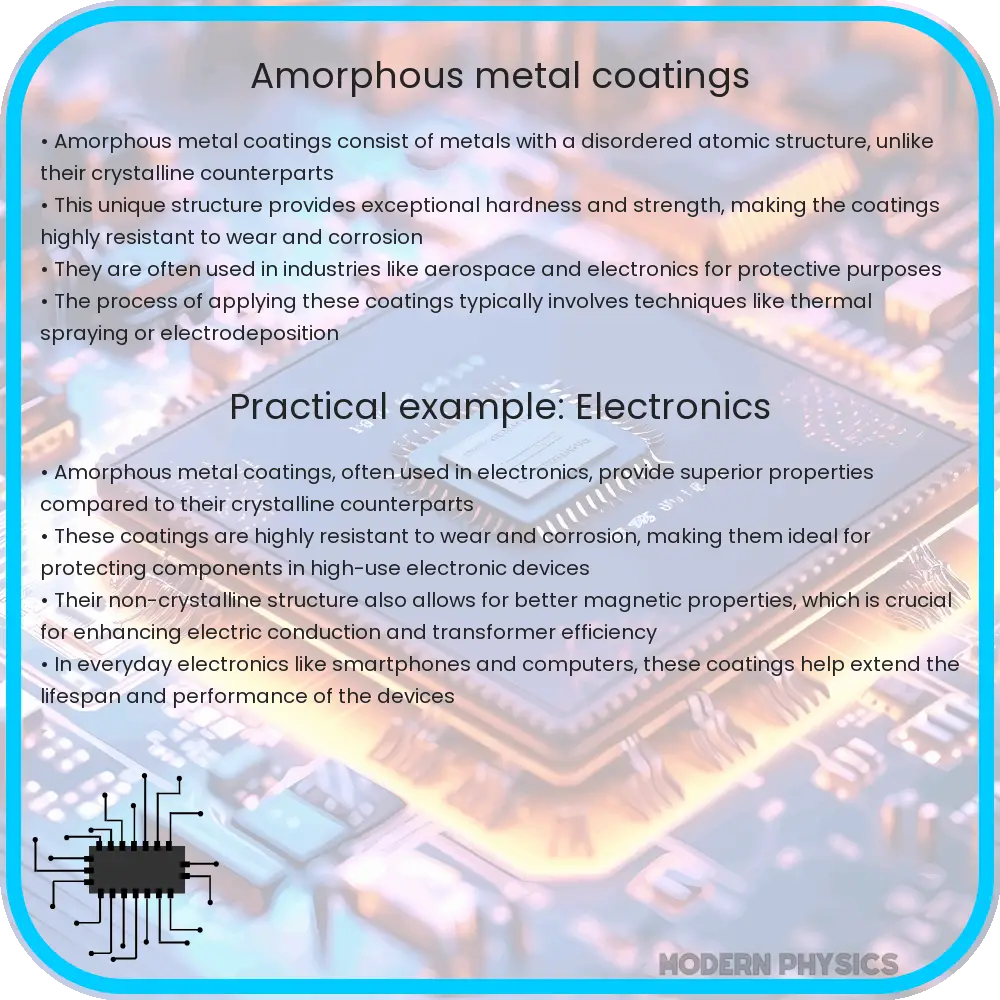Amorphous metal coatings, also known as metallic glasses, lack a crystalline structure, offering enhanced durability, wear resistance, and performance in various industrial applications.

Understanding Amorphous Metal Coatings
Amorphous metal coatings represent a groundbreaking frontier in material science, offering remarkable properties that benefit various industries. Unlike conventional crystalline metals, amorphous metals lack a long-range ordered structure, which translates into unique physical and chemical characteristics. These coatings are known for their durability, resilience, and efficiency, making them ideal for applications where traditional metals might fail.
Composition and Production
Amorphous metals, also referred to as metallic glasses, are typically produced through rapid solidification processes. This method cools the molten metal at a rate exceeding one million degrees Celsius per second. Such a fast cooling rate prevents the atoms from assuming a well-ordered crystal lattice, resulting in an amorphous structure. The composition of amorphous metal coatings usually involves a combination of metals such as zirconium, nickel, titanium, and copper, often alloyed with non-metals like boron, carbon, or silicon.
Properties of Amorphous Metal Coatings
The lack of grain boundaries in amorphous metals, which are typical in crystalline structures, contributes to their unique properties:
- High Strength and Hardness: The disordered arrangement of atoms provides higher yield strength and hardness compared to their crystalline counterparts.
- Superior Wear Resistance: Amorphous metal coatings exhibit excellent resistance to wear and corrosion, which is crucial for protective applications in harsh environments.
- Reduce Friction: The smooth and non-crystalline surface of these coatings often results in lower friction coefficients, enhancing performance in moving parts and reducing energy losses.
- Enhanced Elasticity: Metallic glasses can store and release elastic energy more efficiently than crystalline metals, making them suitable for precision spring and sensor applications.
Applications of Amorphous Metal Coatings
Due to their outstanding characteristics, amorphous metal coatings are employed in a wide range of sectors:
- Aerospace: Their resistance to wear and thermal stability make them excellent for protective coatings in aircraft components.
- Automotive: Used in parts where durability and wear resistance are critical, such as in gears and valves.
- Electronics: Amorphous metals are used in the manufacturing of thin-film transformers and other components where their magnetic properties are advantageous.
- Medical Devices: Their biocompatibility and smooth surface finish make amorphous metals ideal for implants and surgical tools.
The applications of amorphous metal coatings continue to expand as research deepens and technology advances. Understanding the mechanisms behind their formation and their behavior under different conditions is essential for harnessing their full potential.
Future Prospects and Challenges
The future of amorphous metal coatings appears promising, with ongoing research aimed at enhancing their properties and discovering new applications. However, several challenges must be addressed to fully realize their potential. One of the main hurdles is the cost of production, primarily due to the high cooling rates and the use of rare or expensive materials required to maintain the amorphous structure. Additionally, scaling up the manufacturing process while maintaining the quality and uniformity of the coatings can be challenging.
Efforts are underway to develop more cost-effective production techniques and to find cheaper material combinations that retain the desirable properties of amorphous metals. Advancements in simulation and modeling are also helping scientists and engineers better understand the formation of amorphous structures and predict their behavior in practical applications.
Environmental Impact
Amorphous metal coatings are not only advantageous due to their mechanical and physical properties but also offer environmental benefits. Their superior durability and resistance to corrosion can significantly prolong the lifecycle of products, reducing waste and the need for frequent replacements. Furthermore, their efficiency in applications like electrical transformers contributes to reduced energy consumption, which is crucial for sustainable development.
As industries continue to focus on green manufacturing processes and sustainable materials, amorphous metals are likely to play a critical role. By improving the energy efficiency of devices and reducing resource depletion, these materials align well with environmental sustainability goals.
Conclusion
Amorphous metal coatings are a transformative advancement in material science, bridging the gap between the needs of modern engineering applications and the limitations of traditional materials. With their unparalleled strength, wear resistance, and versatility, these coatings have carved a niche in various industries, including aerospace, automotive, electronics, and medical devices. Despite facing challenges such as production costs and scalability, the potential of metallic glasses continues to grow as research provides deeper insights and technology evolves. The environmental benefits they offer further enhance their appeal, positioning amorphous metals as a key player in the future of sustainable materials technology.
As our understanding and technology progress, amorphous metal coatings are set to revolutionize industries, offering smarter and more sustainable solutions that could dramatically alter how we use materials in manufacturing and product development.
